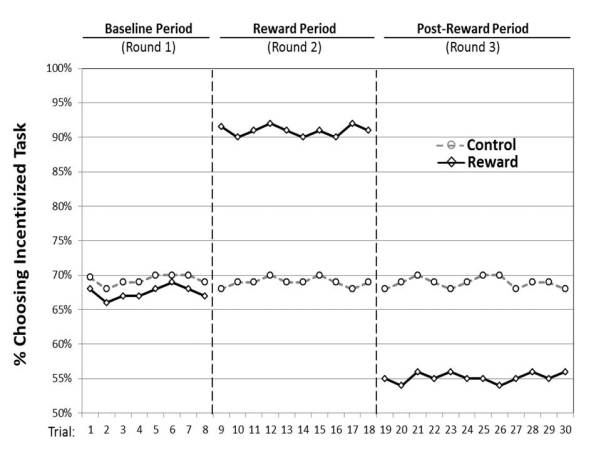[4th post in a series; start with the first post here]
This week, I’ve laid out a puzzle: motivational theories and research suggest that incentives reduce intrinsic motivation, so that task engagement is lower when a temporary incentive ends than if the incentive had never been offered in the first place. This suggests that offering people temporary incentives for performance will backfire. But tests of incentives in real-world settings have all found either no long-term effects or positive long-term effects.
Indranil Goswami tackled this puzzle in his dissertation, which has just been published in the January issue of JEP:General. Prior studies generally only measured people’s behavior right after the incentive ended. Indranil designed a new test to see how motivation to engage in a task compared before, during and after an incentive, and how it changed over time.
In his studies, people are given repeated choices between doing a 30 second math problem and watching a 30 second video. There were three rounds:
Round 1: Participants made eight choices between math problems and videos.
Round 2: For half the people, an incentive was offered for the math task (5 cents for every time they chose the math problem and solved it correctly). Participants were told that the incentive would only apply in the current round. For the other half of the people, no incentive was mentioned. All participants made ten choices.
Round 3: The key test: all participants made another 12 choices between a math task and watching a video, with no incentives.
People who were given an incentive in Round 2 will probably do more of the math tasks while the incentive is available, compared to those who weren’t paid to do math. But what will happen in Round 3, when the incentive has ended and is no longer available?
According to the psychological theories we’ve been discussing, people who were never paid still have their intrinsic motivation intact, and will keep doing the math, to the degree they find it interesting. But for people who were paid to do math during Round 2, the math task is now different — it either no longer provides autonomy, or they will have inferred that it’s an uninteresting task –and they won’t want to do it anymore in Round 3, now that they’re not being paid. So, the results would be predicted to look like this:
PREDICTED RESULTS:

Going back to the Deci, Koestner and Ryan paper, Indranil’s experiments correspond to a tangible expected reward that is performance contingent, which resulted in a negative effect on subsequent performance (d=-.28) in the 32 such studies they reviewed. If we were to ask Alfie Kohn, he would presumably endorse the Control (no payment) condition — sure, the payment gives us a short-term increase in the math task during Round 2, but at what cost to long-term motivation?
Economists would tend to disagree, however. Incentives should increase the number of math tasks when people are being paid, but why would it have a negative effect afterwards? Once the incentive ends, people should go back to doing as many math tasks as they enjoy, as if the incentive had never happened. Or, if the incentive actually helped them improve at the task by getting them to practice more in Round 2, then maybe they would continue to do a bit more than they had been doing before, as suggested by Fryer’s studies, which I discussed in the last post.
Indranil conducted a series of experiments, varying multiple factors. Across the experiments, he had nearly 1100 participants who were in the versions described above. This chart summarizes what he found:
ACTUAL RESULTS:

In Round 1, the two groups were the same. Then, in Round 2, people who could earn money for solving the math problems did a lot more math problems, when they could earn money. That makes sense. The key question is what happens next, when the incentive ends.
In Trial 19, when the incentive ended, those people who had previously been paid to do math were suddenly a lot less likely to choose the math tasks. They wanted to watch a video, not only more than they had before, but also more than the people who had never been paid an incentive in the first place. So it looks like intrinsic motivation was reduced — but only for a while. It was still the case but weaker in Trial 20, and the difference was effectively eliminated by Trial 21.
So, after a minute and a half, a mere three choices later, the story had changed. Whether the person had been paid an incentive or not didn’t matter for their willingness to do math rather than watch videos. After a few more choices, the pattern actually fully reverses, and the people who had been paid before are now doing more math problems, for free.
In a sense, both sets of findings from prior research were vindicated. The immediate negative post-incentive effects on behavior that had been found in previous lab experiments were found here too. On the other hand, the lack of an overall negative post-incentive effect observed in the field studies was replicated here as well.
What does it all mean? As far as policy implications, the results are quite inconsistent with the dire warnings about incentives. Providing a temporary incentive can yield a boost in behavior while people are being paid, and only a small and brief decline afterwards. Maybe incentives work pretty well after all.